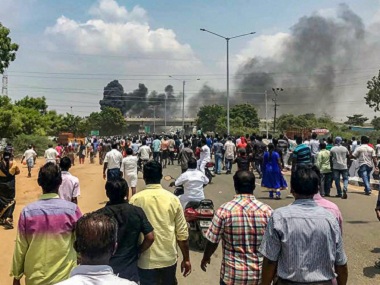The visual of two policemen, both in plainclothes, taking aim with their assault rifles, atop a police vehicle has come to define the Tuticorin killings. The target: Anti-Sterlite protesters, unarmed, unprepared for the bullets. [caption id=“attachment_4479205” align=“alignleft” width=“380”]  Protests in Toothukudi turned violent on Tuesday. PTI[/caption] In a video released by news agency ANI on the night of 22 May, the voice of another person, presumably another policeman, gives the entire sequence a chilling edge. Chennaite Vijayveerappan Swaminathan was the first to spot the faintly audible order, revealing that the deaths were purportedly pre-meditated. You can hear the instruction given to the commando in Tamil: “At least one person should die”. The sniper fires. By the end of Tuesday, eleven people had been killed in Tuticorin, most of the bullet marks above the abdomen. What else do you call such a trigger-happy approach except “mass murder” or “State-sponsored terrorism”? Both phrases used by Opposition leaders. Where the State turns the gun on its own people. Where the State plays the politics of blame game once the men and women start falling like dead birds. #TNJallianwalaBagh is trending on Twitter. One cannot help but feel terrible that a part of India has to revisit a terrible tragedy that took place 99 years ago, to describe its state of mind. Without a doubt, the protest turned violent. The mob vandalised the collectorate, smashing window panes, and set vehicles and files on fire. Were there outside radical elements who infiltrated the agitation to foment trouble? We do not know. Intelligence inputs indicated their presence and even the Madurai bench of the Madras High Court warned there could be trouble. Yet, Tamil Nadu slept, with its deployment on the ground hardly sufficient to tackle a crowd of 20,000. They probably derived confidence from the fact that when push comes to shove, the rifles will be in their hands. And a death wish on their lips: “At least one should die’’. The police manual makes it clear: Opening fire is the last resort. If the gathering does not disperse on verbal orders, tear gas, lathicharge, water cannon ought to be used in that order. If none of them work, the police has to announce it will fire, via megaphone. It should fire in the air or below the hip. Or use rubber bullets as deterrent. But the police in Tuticorin behaved like encounter specialists, killing people in cold blood. It was not as if the government was unaware that it was the 100th day of protest. The question is whether the judicial probe by retired judge Aruna Jagadeesan will fix culpability of only the district administration or from the chief minister, chief secretary and DGP downwards. Did Edappadi Palaniswamy brief the district minister and the collector on how to handle the situation? All we know is that EPS was inaugurating a flower show in Ooty last week. But Tuticorin’s battle against Sterlite did not begin only this year. For over twenty years, the locals have been raising their voice against what they call is a Union Carbide-like monster planted in their backyard. In fact, the plant was moved to Tamil Nadu after protests by locals and environmentalists in Maharashtra and Goa where it was originally planned. PMK leader Anbumani Ramadoss alleges corruption as the reason why Tamil Nadu agreed to hosting Sterlite in the 1990s. Successive governments and environmental authorities have done little to listen to Tuticorin. In March 2013, the Tamil Nadu Pollution Control Board (TNPCB) shut down the plant after leakage of noxious gas. But just three months later, the National Green Tribunal okayed the reopening of the unit. On 31 March, the TNPCB refused to renew the Consent to Operate certificate and the plant was shut. But locals aware of Sterlite’s clout want the closure to be permanent. Where the ruling political class failed was in its refusal to engage with the villagers, to tell them that their interest is paramount. In the worldview of the locals, Tuticorin paid a heavy price. Then there is also the trust deficit vis-a-vis judicial commissions that are seen as time-buying tactics. For instance, Justice S Rajeswaran, who was appointed to probe into the causes and circumstances leading to the law and order disturbances in Chennai and other parts of Tamil Nadu in January 2017 after the Marina uprising over Jallikattu, was given three months to submit its report. In January, the retired judge said he will take another year to submit his findings. A victory in the aftermath of the violence on Tuesday is the stay ordered by the Madras High Court on the construction of the second copper smelter plant by Sterlite in Tuticorin. The group planned to invest Rs 2,500 crore to double manufacturing capacity to 8 lakh metric tonnes per annum. The carrot offered was in terms of jobs for the local population: 2,000, up from the present 1,200. But the trade-off was worse. Cancer. Skin diseases. Breathing trouble. Regular ailments. Groundwater contamination. In a nutshell, slow death. It is a commentary on the quality of governance in India that the demand of civil society for clean air, water and land is ignored when the protest is Gandhian. Pushed to the wall, when anger trumps reason, the State responds with a death warrant. “At least one should die’’ was not meant only for the protesters in Tuticorin. In the long run, we are all dead. Click here for LIVE updates on Sterlite protests
The visual of two policemen, both in plainclothes, taking aim with their assault rifles, atop a police vehicle has come to define the Tuticorin killings. The target: Anti-Sterlite protesters, unarmed, unprepared for the bullets.
Advertisement
End of Article


)

)
)
)
)
)
)
)
)



